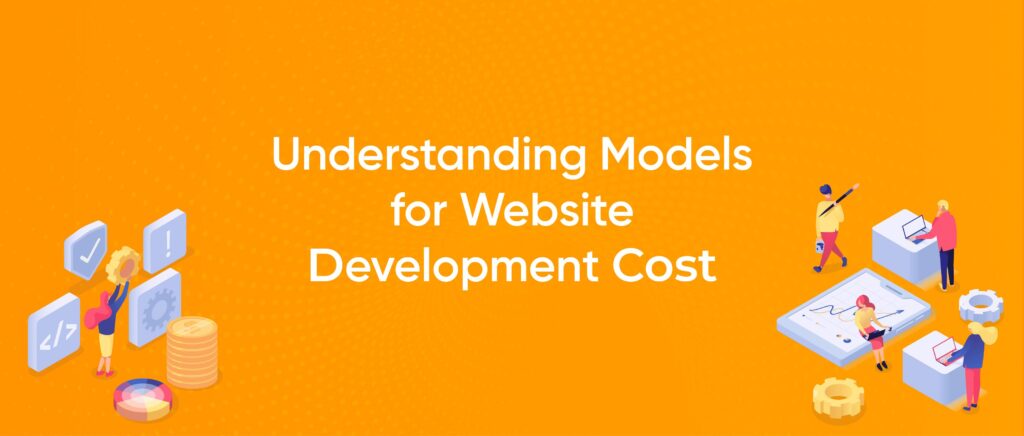Understanding Models for Website Development Cost

A website is an indispensable part of a business’ online presence. It doesn’t matter if you are a small business, entrepreneur, an established venture or a large corporation- your website is often the first solid impression that the audience will have of your brand. So, it is important that yours is a good one. We discussed all about website development in our previous blogs, which you can read here. In this article, we will be talking about what are the models for website development cost? We shall explore the three primary pricing methods- hourly, fixed and subscription based. Understanding these will help you make an informed decision that aligns with your budget and goals.
Why the Pricing Model Matters
The pricing model you choose isn’t just about cost; it influences multiple aspects of your project, ultimately determining its success. Here’s how different factors come into play:
Budget Management

Firstly and most importantly, the pricing model will decide if you will have a clear understanding of the total cost from the start or if it will evolve over time as the project progresses. Fixed pricing offers upfront clarity while hourly and subscription models are more dynamic depending on the scope of work and ongoing requirements.
Timeline
The pricing model also impacts how efficiently the project is completed. Fixed pricing usually comes with a set timeline, ensuring that deliverables are met on time on a stricter note. On the other hand, hourly or subscription based pricing models would allow a more flexible approach. This could also lead to delays if they are not managed efficiently.
Scalability
The pricing model determines how easily your website can accommodate changes or future updates. Subscription models, for instance, are inherently scalable and designed to grow with your business. Hourly pricing provides flexibility for mid-project adjustments, while fixed pricing would need re-negotiations for additional features or modifications.
Quality
While cost-saving models may seem appealing, they can hamper the quality if not selected with care. Fixed pricing can push agencies to work within a pre-determined budget, potentially leading to hurried results if time estimates are off. On the other hand, hourly models typically enable a greater focus on quality, as developers can invest the time needed to refine features. Subscription models strike a balance between quality and cost by offering ongoing support and enhancements over time.
Selecting the right pricing model ensures that your project not only meets your expectations but is also delivered on time, within budget, and built to last. By aligning the pricing approach with your priorities- whether they are budget certainty, adaptability, or high-quality development- you set the foundation for a successful website.
Hourly Pricing Model

How It Works
With the hourly pricing model, the website development cost are a set rate for every hour spent on your project. This transparent approach allows clients to see exactly how much time is devoted to each task, often tracked through timesheets or project management tools.
Pros
- Flexibility: Easily accommodates changing project requirements.
- Transparency: Clients can track exactly how time is spent.
- Customisation: Suitable for highly tailored or complex projects.
Cons
- Unpredictable Costs: Final costs can exceed initial estimates.
- Requires Oversight: Regular monitoring is necessary to avoid overspending.
- No Set Total: It’s difficult to determine the final cost at the start.
Best For
- Projects with undefined or evolving scopes.
- Businesses that require frequent updates or ongoing development.
- Custom development tasks that may vary in complexity.
Fixed Pricing Model
How It Works
In a fixed pricing model, the agency provides a single, upfront cost for the entire project based on clearly defined deliverables and timelines. Once the contract is signed, the price doesn’t change unless there’s a significant adjustment in scope.
Pros
- Predictable Costs: Clients know the total expense upfront.
- Simplified Budgeting: Easier to plan finances.
- Clear Expectations: Encourages detailed scoping at the outset.
Cons
- Limited Flexibility: Scope changes can result in additional charges.
- Risk of Overcharging: Agencies may include buffer costs for unexpected delays.
- Potential Trade-Offs: Agencies might prioritise speed over quality to stay within budget.
Best For
- Projects with a well-defined scope.
- Clients with strict budgets and timelines.
- Small to medium-sized businesses looking for a straightforward process.
Subscription-Based Pricing Model
How It Works
Subscription-based pricing involves recurring monthly or annual payments for website development and ongoing services like maintenance, hosting, and updates. This model spreads the cost over time, providing continuous support.
Pros
- Ongoing Support: Covers maintenance, updates, and troubleshooting.
- Lower Upfront Costs: Ideal for businesses with limited initial budgets.
- Scalability: Allows for gradual feature additions as your business grows.
Cons
- Long-Term Costs: Subscriptions may cost more over time than one-off projects.
- Dependence on Provider: Switching agencies can be challenging.
- Lack of Ownership: In some cases, the agency retains control over hosting or code.
Best For
- Startups and small businesses.
- Companies needing ongoing updates and maintenance.
- Clients who prefer spreading costs over time.
Hybrid Pricing Models
Many providers offer hybrid pricing models as the best of all worlds. These models are combination of certain elements of fixed, hourly, or subscription-based pricing to create a more tailored and flexible approach for clients. Here’s how they typically work:
Common Examples of Hybrid Models
Fixed + Hourly Model:
This could be followed in a scenario where the core deliverables such as the website’s basic structure and key features are given at a fixed rate. Other additional features and/or adjustments are made on an hourly pricing basis. This allows a balance between predictability and flexibility.
Subscription + Upfront Fee:
Under this model, the initial set-up is asked at first as the set-up fee that would cover the website development work. After this, other work for the website such as maintenance, updates and support would be billed on a subscription model.
For example, an agency might say that the website development cost is £2,000 upfront for building the website and £150/month for hosting, regular updates, and troubleshooting. This is particularly useful for businesses that need long-term support but also want to pay for the initial work separately.
Advantages of Hybrid Models
- Customisation: Hybrid models allow clients to tailor the pricing structure to their specific needs, ensuring that both the core project and ongoing requirements are addressed effectively.
- Cost Management: By combining predictable fixed costs with flexible hourly or subscription elements, businesses can better manage budgets while accommodating unforeseen changes or future growth.
- Scalability: These models support incremental development and updates, making them ideal for businesses with evolving requirements.
- Client-Agency Alignment: Hybrid models foster better collaboration by giving agencies the flexibility to adapt to client needs while maintaining clear boundaries for scope and costs.
Drawbacks of Hybrid Models
- Complexity: The combination of pricing structures can make contracts and billing more complicated, requiring clear communication and documentation.
- Potential Overlaps: Clients must ensure they aren’t paying twice for similar services (e.g., upfront for development and again through a subscription).
Best For
- Medium to large projects with evolving scopes.
- Businesses seeking a long-term partnership with an agency.
- Clients who value both predictability and flexibility in pricing.
By offering the adaptability of hourly or subscription models alongside the clarity of fixed pricing, hybrid approaches can be a win-win for both agencies and clients, ensuring projects are completed efficiently and to a high standard without compromising on budgetary control.
Hidden Costs to Watch Out For

Even with a clear pricing model, additional expenses can arise. Be aware of potential hidden costs such as:
Domain and Hosting Fees:
Domains cost £10-£50 annually, while hosting ranges from £5-£200/month depending on the provider and service level.
Content Creation:
Professional copywriting, photography, and videography will add to the budget.

Third-Party Integrations:
Plugins, APIs, and premium tools often have separate costs.
Maintenance and Updates:
Even fixed-price projects may require ongoing updates to stay secure and functional.
SEO and Marketing Add-Ons:
Advanced SEO or digital marketing services are usually not included in base website development cost.

How to Choose the Right Pricing Model
Key Considerations
- Budget:
- Fixed pricing suits tight budgets.
- Hourly pricing works for flexible budgets and undefined scopes.
- Subscription models are ideal for spreading costs.
- Project Complexity:
- Basic websites may only need fixed or subscription pricing.
- Complex, custom projects often benefit from hourly or hybrid models.
- Timeline:
- Fixed pricing ensures a clear deadline.
- Hourly or subscription models allow for iterative, long-term development.
- Future Needs:
- Subscription models offer scalability.
- Fixed pricing limits future flexibility.
Questions to Ask
- What’s included in the cost?
- How are changes in scope handled?
- What’s the agency’s policy on maintenance and support?
- Are there any additional fees for third-party tools or integrations?
Final Thoughts
Understanding the models for website development costs empowers you to choose the right model for your business. Whether you prefer hourly, fixed, subscription-based, or hybrid pricing, the key is aligning the model with your goals, budget, and long-term needs. By asking the right questions and accounting for hidden costs, you can avoid surprises and ensure your project delivers maximum value.
Remember, a well-built website is an investment, not just an expense. Choose an agency that prioritises your success, and your website will become a powerful tool for growth and engagement.
Frequently Asked Questions (FAQs)
1. What factors influence website development cost?
Complexity, design, functionality, timeline, and agency expertise are key factors.
2. Are subscription models worth it?
They’re ideal for businesses needing ongoing support, updates, and scalability.
3. How do I ensure my project stays within budget?
Define your scope clearly, communicate regularly with your agency, and avoid unnecessary changes.
4. Which pricing model is the cheapest?
The website development cost depends on your needs. While the fixed pricing offers predictability, hourly or subscription models might be more cost-effective for certain projects.
5. How do I find the right agency?
Evaluate portfolios, read reviews, and choose an agency with transparent pricing and strong communication.






